Modern Workplace: Tesco's Structure, Culture, and Performance Analysis
VerifiedAdded on 2023/01/11
|9
|2741
|37
Report
AI Summary
This report provides an in-depth analysis of Tesco's modern workplace, examining its organizational structure and culture, and how these factors contribute to its overall performance. The report delves into the key elements of Tesco's structure, including its size and the distribution of responsibilities, and also explores the company's efforts to cultivate a positive work culture. It discusses the impact of this culture on employee satisfaction, motivation, and productivity. Furthermore, the report applies relevant organizational culture models, such as Handy's model, to analyze Tesco's approach to leadership and employee management. The report concludes by summarizing the key findings and emphasizing the importance of a modern workplace in achieving business success.
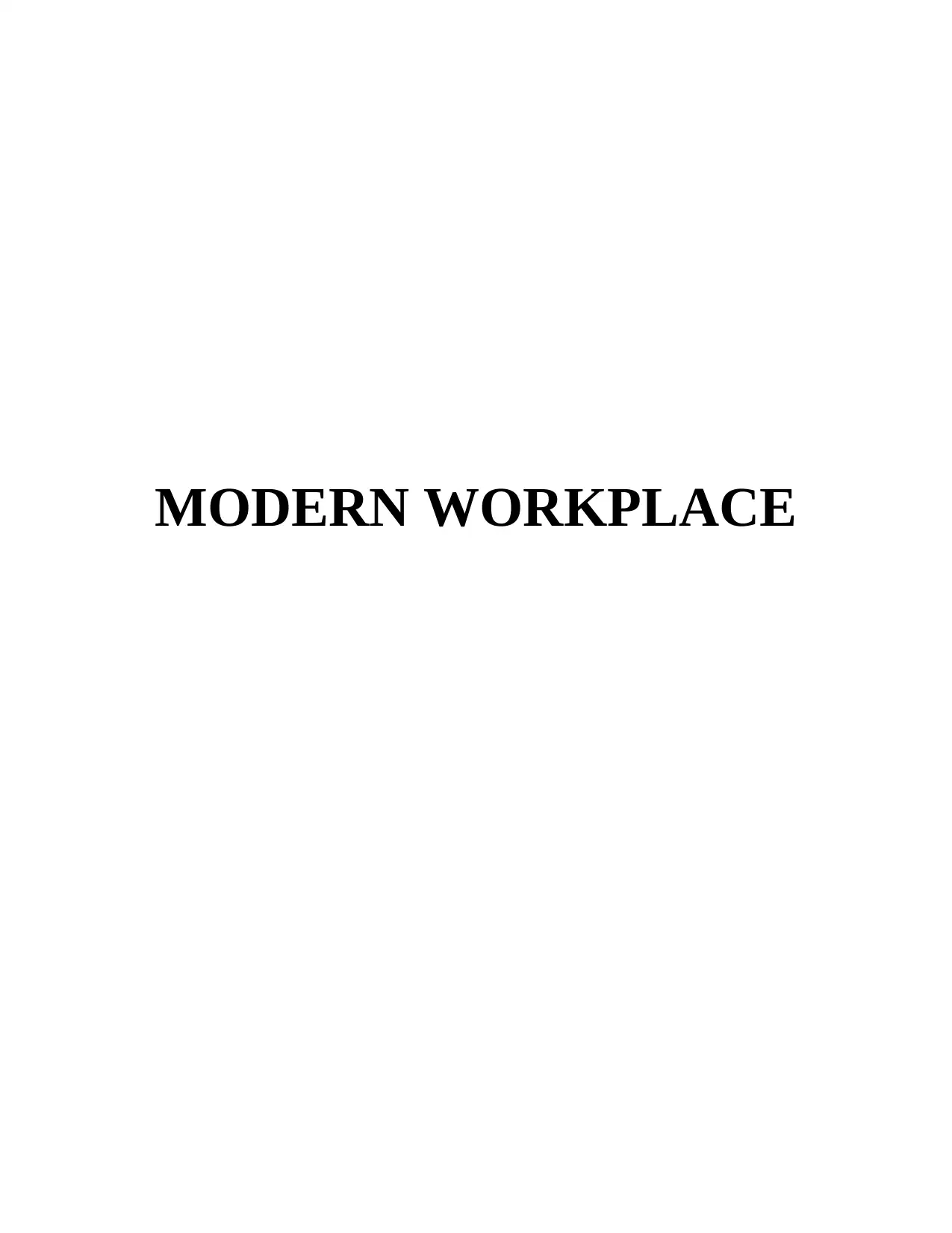
MODERN WORKPLACE
Paraphrase This Document
Need a fresh take? Get an instant paraphrase of this document with our AI Paraphraser
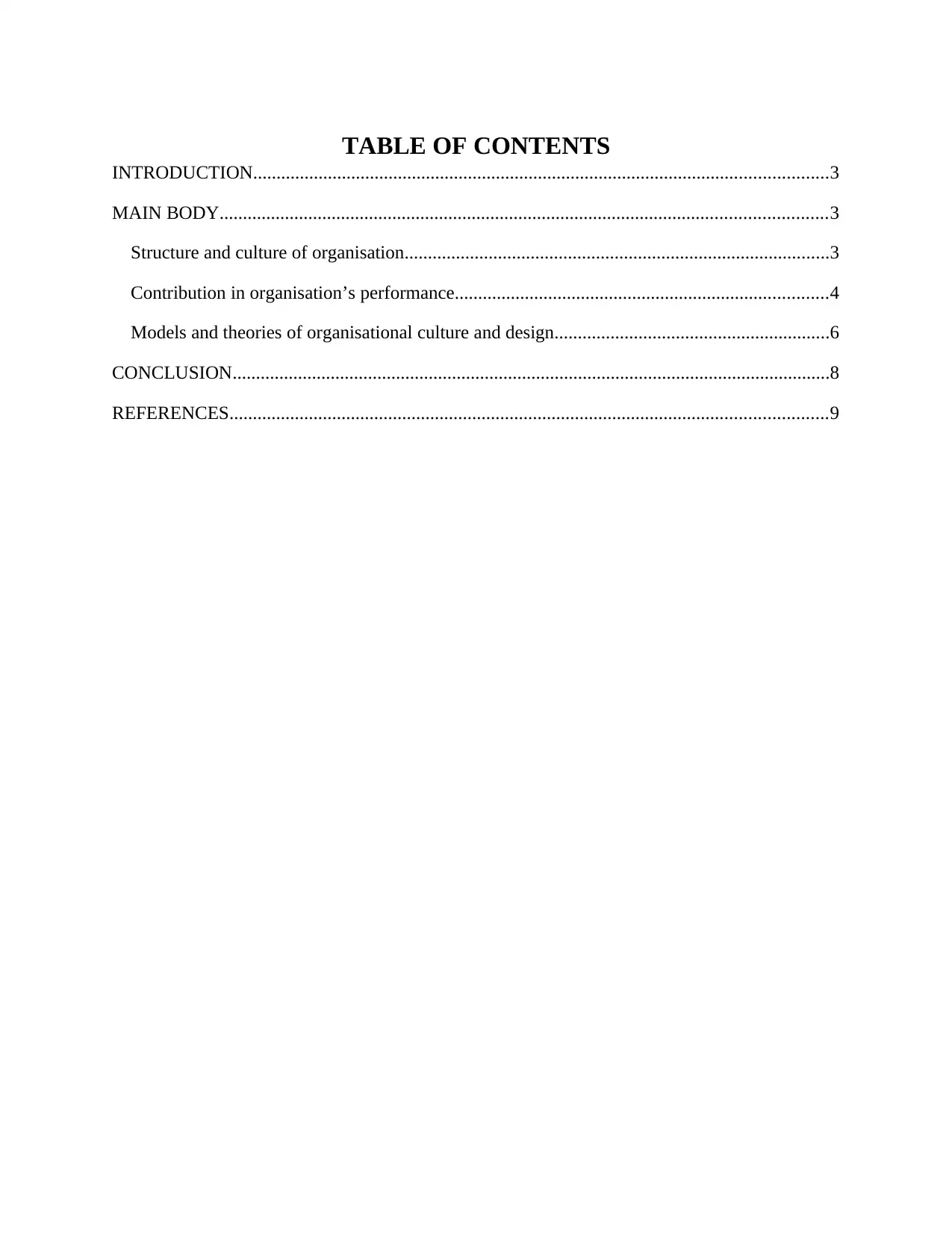
TABLE OF CONTENTS
INTRODUCTION...........................................................................................................................3
MAIN BODY..................................................................................................................................3
Structure and culture of organisation...........................................................................................3
Contribution in organisation’s performance................................................................................4
Models and theories of organisational culture and design...........................................................6
CONCLUSION................................................................................................................................8
REFERENCES................................................................................................................................9
INTRODUCTION...........................................................................................................................3
MAIN BODY..................................................................................................................................3
Structure and culture of organisation...........................................................................................3
Contribution in organisation’s performance................................................................................4
Models and theories of organisational culture and design...........................................................6
CONCLUSION................................................................................................................................8
REFERENCES................................................................................................................................9
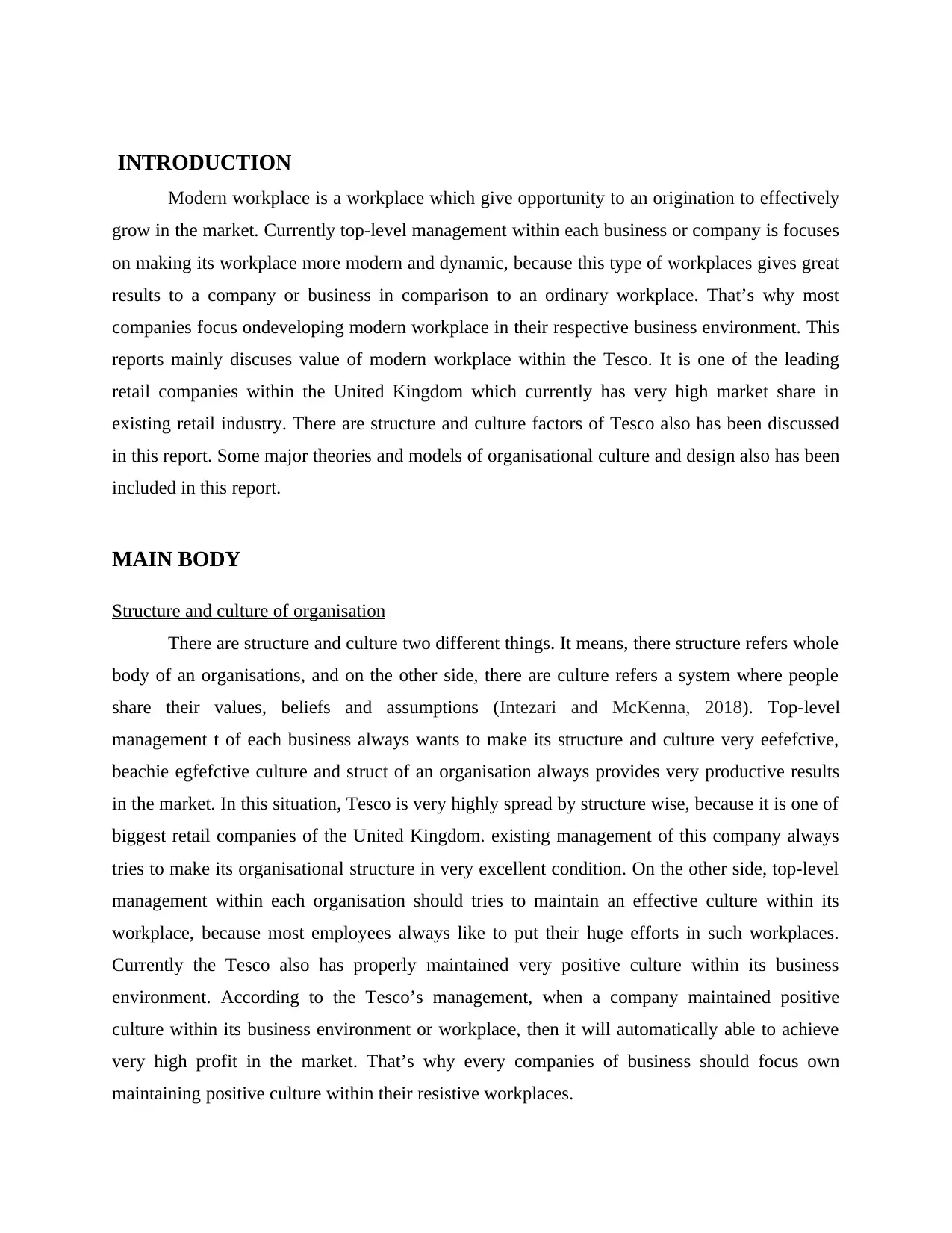
INTRODUCTION
Modern workplace is a workplace which give opportunity to an origination to effectively
grow in the market. Currently top-level management within each business or company is focuses
on making its workplace more modern and dynamic, because this type of workplaces gives great
results to a company or business in comparison to an ordinary workplace. That’s why most
companies focus ondeveloping modern workplace in their respective business environment. This
reports mainly discuses value of modern workplace within the Tesco. It is one of the leading
retail companies within the United Kingdom which currently has very high market share in
existing retail industry. There are structure and culture factors of Tesco also has been discussed
in this report. Some major theories and models of organisational culture and design also has been
included in this report.
MAIN BODY
Structure and culture of organisation
There are structure and culture two different things. It means, there structure refers whole
body of an organisations, and on the other side, there are culture refers a system where people
share their values, beliefs and assumptions (Intezari and McKenna, 2018). Top-level
management t of each business always wants to make its structure and culture very eefefctive,
beachie egfefctive culture and struct of an organisation always provides very productive results
in the market. In this situation, Tesco is very highly spread by structure wise, because it is one of
biggest retail companies of the United Kingdom. existing management of this company always
tries to make its organisational structure in very excellent condition. On the other side, top-level
management within each organisation should tries to maintain an effective culture within its
workplace, because most employees always like to put their huge efforts in such workplaces.
Currently the Tesco also has properly maintained very positive culture within its business
environment. According to the Tesco’s management, when a company maintained positive
culture within its business environment or workplace, then it will automatically able to achieve
very high profit in the market. That’s why every companies of business should focus own
maintaining positive culture within their resistive workplaces.
Modern workplace is a workplace which give opportunity to an origination to effectively
grow in the market. Currently top-level management within each business or company is focuses
on making its workplace more modern and dynamic, because this type of workplaces gives great
results to a company or business in comparison to an ordinary workplace. That’s why most
companies focus ondeveloping modern workplace in their respective business environment. This
reports mainly discuses value of modern workplace within the Tesco. It is one of the leading
retail companies within the United Kingdom which currently has very high market share in
existing retail industry. There are structure and culture factors of Tesco also has been discussed
in this report. Some major theories and models of organisational culture and design also has been
included in this report.
MAIN BODY
Structure and culture of organisation
There are structure and culture two different things. It means, there structure refers whole
body of an organisations, and on the other side, there are culture refers a system where people
share their values, beliefs and assumptions (Intezari and McKenna, 2018). Top-level
management t of each business always wants to make its structure and culture very eefefctive,
beachie egfefctive culture and struct of an organisation always provides very productive results
in the market. In this situation, Tesco is very highly spread by structure wise, because it is one of
biggest retail companies of the United Kingdom. existing management of this company always
tries to make its organisational structure in very excellent condition. On the other side, top-level
management within each organisation should tries to maintain an effective culture within its
workplace, because most employees always like to put their huge efforts in such workplaces.
Currently the Tesco also has properly maintained very positive culture within its business
environment. According to the Tesco’s management, when a company maintained positive
culture within its business environment or workplace, then it will automatically able to achieve
very high profit in the market. That’s why every companies of business should focus own
maintaining positive culture within their resistive workplaces.
⊘ This is a preview!⊘
Do you want full access?
Subscribe today to unlock all pages.

Trusted by 1+ million students worldwide
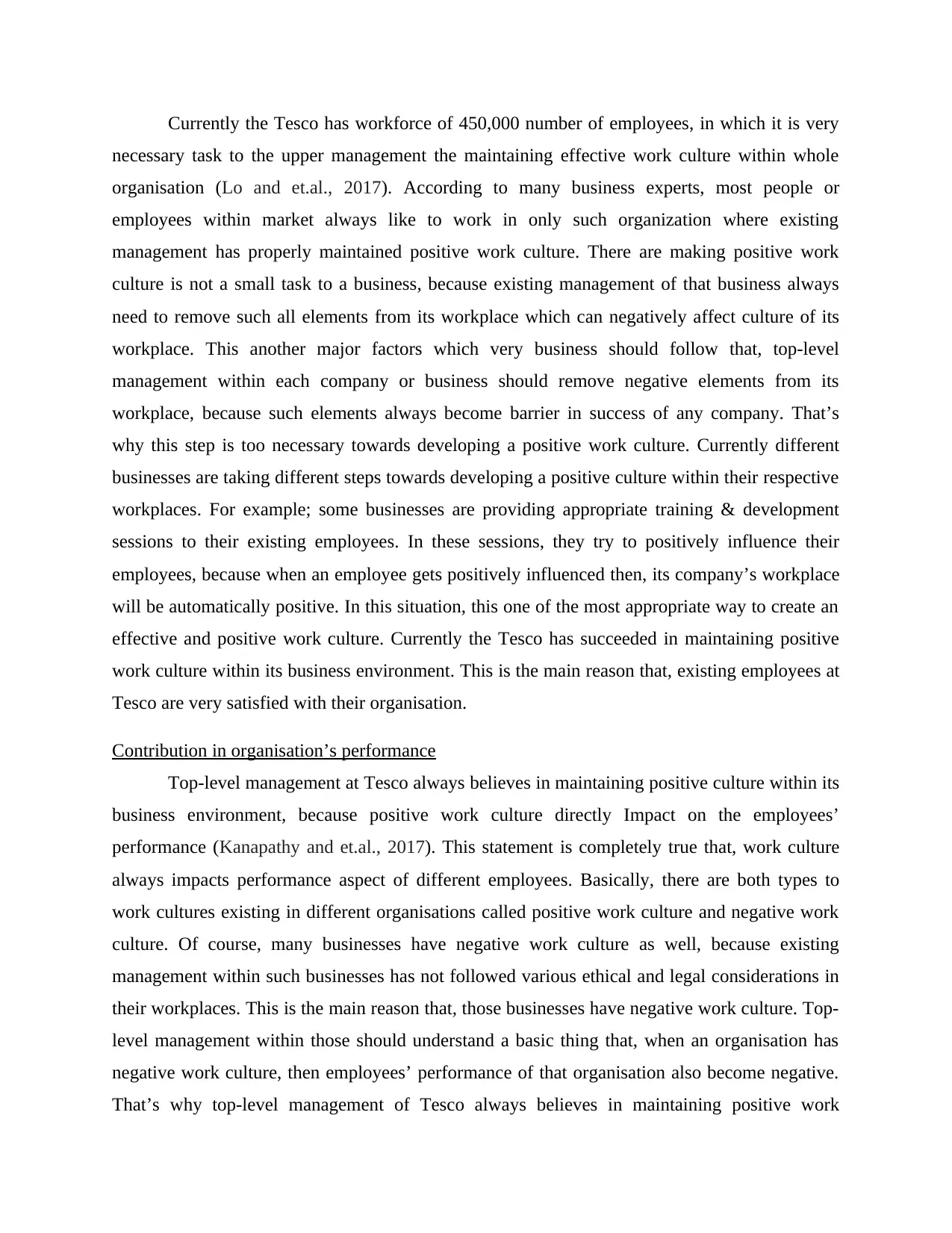
Currently the Tesco has workforce of 450,000 number of employees, in which it is very
necessary task to the upper management the maintaining effective work culture within whole
organisation (Lo and et.al., 2017). According to many business experts, most people or
employees within market always like to work in only such organization where existing
management has properly maintained positive work culture. There are making positive work
culture is not a small task to a business, because existing management of that business always
need to remove such all elements from its workplace which can negatively affect culture of its
workplace. This another major factors which very business should follow that, top-level
management within each company or business should remove negative elements from its
workplace, because such elements always become barrier in success of any company. That’s
why this step is too necessary towards developing a positive work culture. Currently different
businesses are taking different steps towards developing a positive culture within their respective
workplaces. For example; some businesses are providing appropriate training & development
sessions to their existing employees. In these sessions, they try to positively influence their
employees, because when an employee gets positively influenced then, its company’s workplace
will be automatically positive. In this situation, this one of the most appropriate way to create an
effective and positive work culture. Currently the Tesco has succeeded in maintaining positive
work culture within its business environment. This is the main reason that, existing employees at
Tesco are very satisfied with their organisation.
Contribution in organisation’s performance
Top-level management at Tesco always believes in maintaining positive culture within its
business environment, because positive work culture directly Impact on the employees’
performance (Kanapathy and et.al., 2017). This statement is completely true that, work culture
always impacts performance aspect of different employees. Basically, there are both types to
work cultures existing in different organisations called positive work culture and negative work
culture. Of course, many businesses have negative work culture as well, because existing
management within such businesses has not followed various ethical and legal considerations in
their workplaces. This is the main reason that, those businesses have negative work culture. Top-
level management within those should understand a basic thing that, when an organisation has
negative work culture, then employees’ performance of that organisation also become negative.
That’s why top-level management of Tesco always believes in maintaining positive work
necessary task to the upper management the maintaining effective work culture within whole
organisation (Lo and et.al., 2017). According to many business experts, most people or
employees within market always like to work in only such organization where existing
management has properly maintained positive work culture. There are making positive work
culture is not a small task to a business, because existing management of that business always
need to remove such all elements from its workplace which can negatively affect culture of its
workplace. This another major factors which very business should follow that, top-level
management within each company or business should remove negative elements from its
workplace, because such elements always become barrier in success of any company. That’s
why this step is too necessary towards developing a positive work culture. Currently different
businesses are taking different steps towards developing a positive culture within their respective
workplaces. For example; some businesses are providing appropriate training & development
sessions to their existing employees. In these sessions, they try to positively influence their
employees, because when an employee gets positively influenced then, its company’s workplace
will be automatically positive. In this situation, this one of the most appropriate way to create an
effective and positive work culture. Currently the Tesco has succeeded in maintaining positive
work culture within its business environment. This is the main reason that, existing employees at
Tesco are very satisfied with their organisation.
Contribution in organisation’s performance
Top-level management at Tesco always believes in maintaining positive culture within its
business environment, because positive work culture directly Impact on the employees’
performance (Kanapathy and et.al., 2017). This statement is completely true that, work culture
always impacts performance aspect of different employees. Basically, there are both types to
work cultures existing in different organisations called positive work culture and negative work
culture. Of course, many businesses have negative work culture as well, because existing
management within such businesses has not followed various ethical and legal considerations in
their workplaces. This is the main reason that, those businesses have negative work culture. Top-
level management within those should understand a basic thing that, when an organisation has
negative work culture, then employees’ performance of that organisation also become negative.
That’s why top-level management of Tesco always believes in maintaining positive work
Paraphrase This Document
Need a fresh take? Get an instant paraphrase of this document with our AI Paraphraser
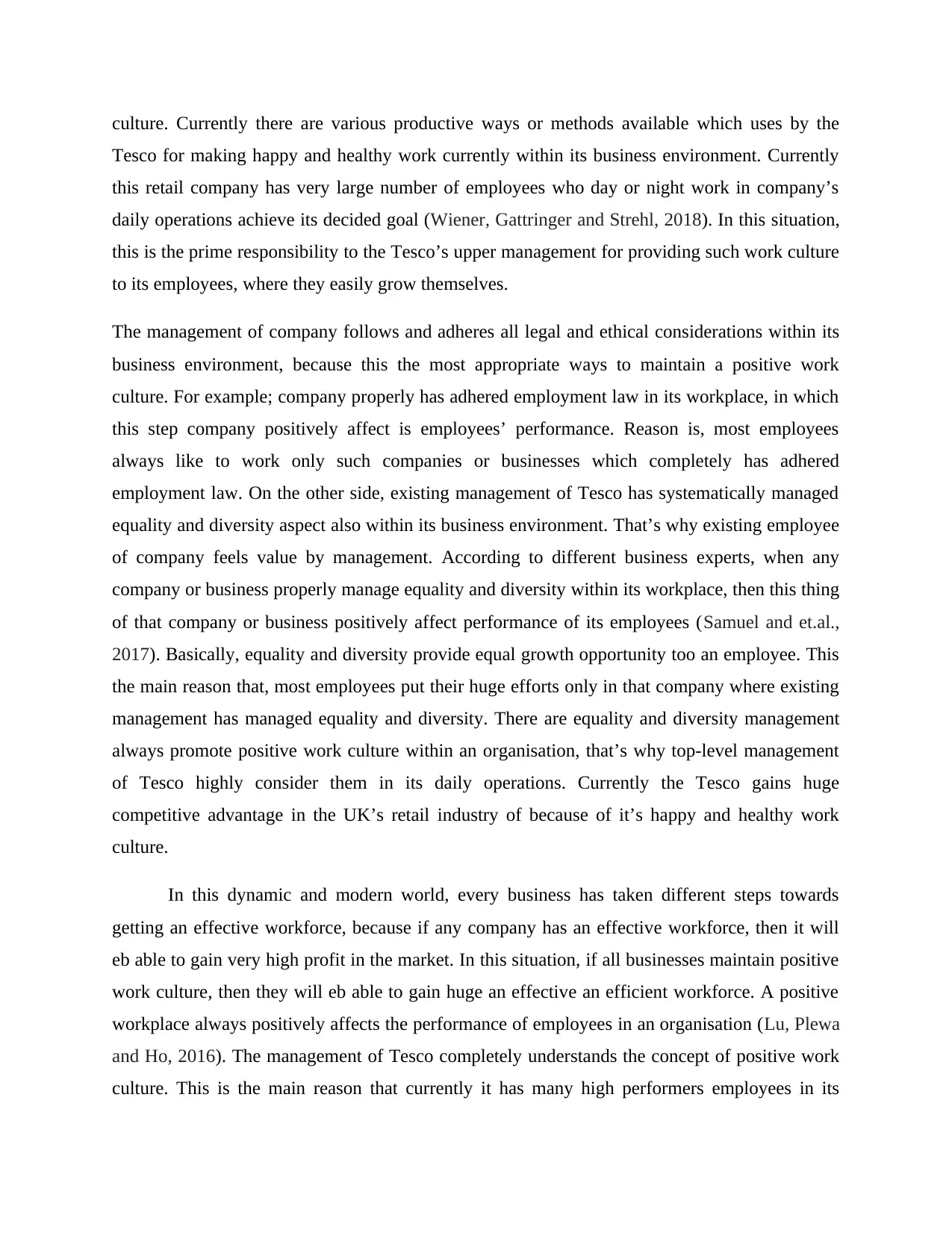
culture. Currently there are various productive ways or methods available which uses by the
Tesco for making happy and healthy work currently within its business environment. Currently
this retail company has very large number of employees who day or night work in company’s
daily operations achieve its decided goal (Wiener, Gattringer and Strehl, 2018). In this situation,
this is the prime responsibility to the Tesco’s upper management for providing such work culture
to its employees, where they easily grow themselves.
The management of company follows and adheres all legal and ethical considerations within its
business environment, because this the most appropriate ways to maintain a positive work
culture. For example; company properly has adhered employment law in its workplace, in which
this step company positively affect is employees’ performance. Reason is, most employees
always like to work only such companies or businesses which completely has adhered
employment law. On the other side, existing management of Tesco has systematically managed
equality and diversity aspect also within its business environment. That’s why existing employee
of company feels value by management. According to different business experts, when any
company or business properly manage equality and diversity within its workplace, then this thing
of that company or business positively affect performance of its employees (Samuel and et.al.,
2017). Basically, equality and diversity provide equal growth opportunity too an employee. This
the main reason that, most employees put their huge efforts only in that company where existing
management has managed equality and diversity. There are equality and diversity management
always promote positive work culture within an organisation, that’s why top-level management
of Tesco highly consider them in its daily operations. Currently the Tesco gains huge
competitive advantage in the UK’s retail industry of because of it’s happy and healthy work
culture.
In this dynamic and modern world, every business has taken different steps towards
getting an effective workforce, because if any company has an effective workforce, then it will
eb able to gain very high profit in the market. In this situation, if all businesses maintain positive
work culture, then they will eb able to gain huge an effective an efficient workforce. A positive
workplace always positively affects the performance of employees in an organisation (Lu, Plewa
and Ho, 2016). The management of Tesco completely understands the concept of positive work
culture. This is the main reason that currently it has many high performers employees in its
Tesco for making happy and healthy work currently within its business environment. Currently
this retail company has very large number of employees who day or night work in company’s
daily operations achieve its decided goal (Wiener, Gattringer and Strehl, 2018). In this situation,
this is the prime responsibility to the Tesco’s upper management for providing such work culture
to its employees, where they easily grow themselves.
The management of company follows and adheres all legal and ethical considerations within its
business environment, because this the most appropriate ways to maintain a positive work
culture. For example; company properly has adhered employment law in its workplace, in which
this step company positively affect is employees’ performance. Reason is, most employees
always like to work only such companies or businesses which completely has adhered
employment law. On the other side, existing management of Tesco has systematically managed
equality and diversity aspect also within its business environment. That’s why existing employee
of company feels value by management. According to different business experts, when any
company or business properly manage equality and diversity within its workplace, then this thing
of that company or business positively affect performance of its employees (Samuel and et.al.,
2017). Basically, equality and diversity provide equal growth opportunity too an employee. This
the main reason that, most employees put their huge efforts only in that company where existing
management has managed equality and diversity. There are equality and diversity management
always promote positive work culture within an organisation, that’s why top-level management
of Tesco highly consider them in its daily operations. Currently the Tesco gains huge
competitive advantage in the UK’s retail industry of because of it’s happy and healthy work
culture.
In this dynamic and modern world, every business has taken different steps towards
getting an effective workforce, because if any company has an effective workforce, then it will
eb able to gain very high profit in the market. In this situation, if all businesses maintain positive
work culture, then they will eb able to gain huge an effective an efficient workforce. A positive
workplace always positively affects the performance of employees in an organisation (Lu, Plewa
and Ho, 2016). The management of Tesco completely understands the concept of positive work
culture. This is the main reason that currently it has many high performers employees in its
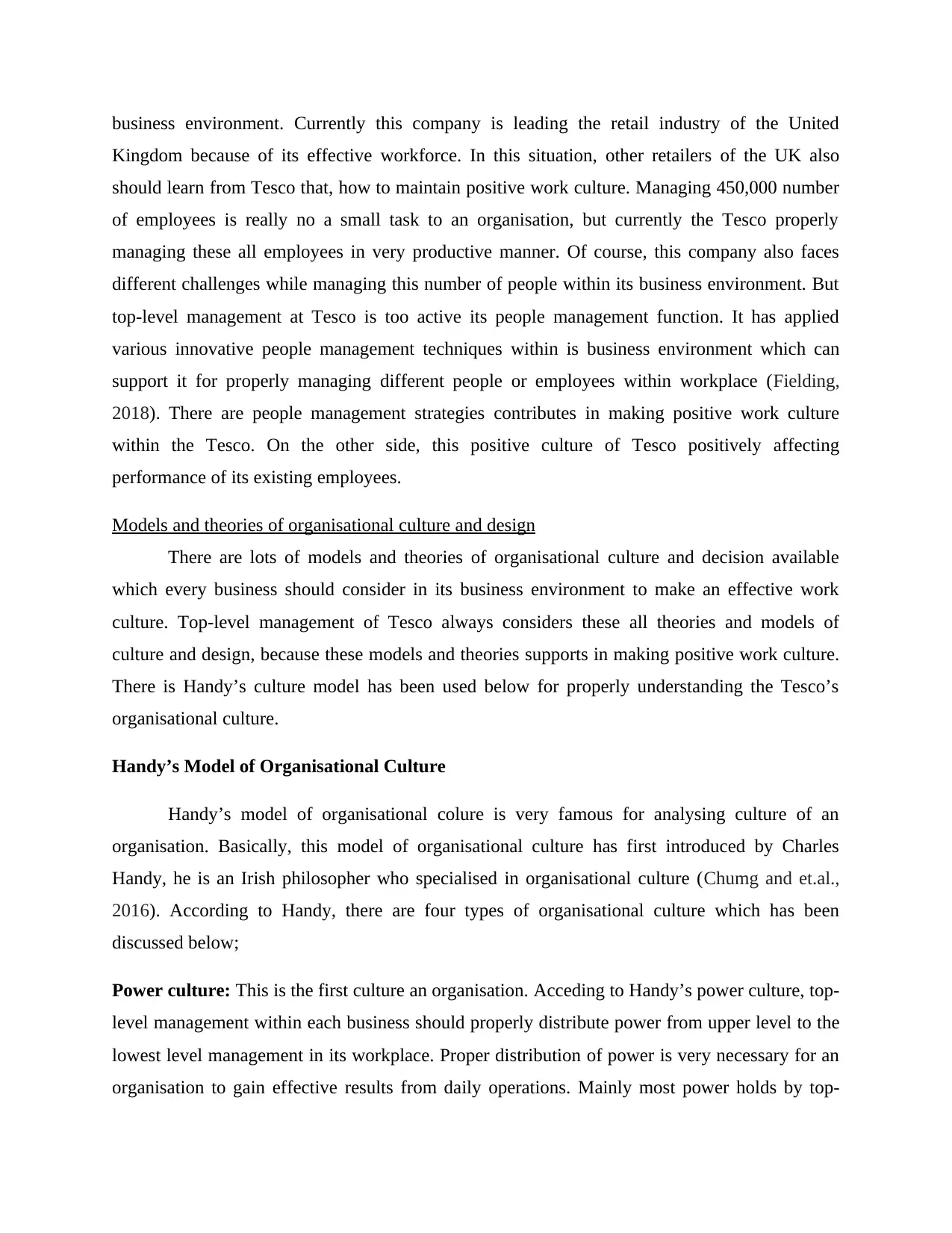
business environment. Currently this company is leading the retail industry of the United
Kingdom because of its effective workforce. In this situation, other retailers of the UK also
should learn from Tesco that, how to maintain positive work culture. Managing 450,000 number
of employees is really no a small task to an organisation, but currently the Tesco properly
managing these all employees in very productive manner. Of course, this company also faces
different challenges while managing this number of people within its business environment. But
top-level management at Tesco is too active its people management function. It has applied
various innovative people management techniques within is business environment which can
support it for properly managing different people or employees within workplace (Fielding,
2018). There are people management strategies contributes in making positive work culture
within the Tesco. On the other side, this positive culture of Tesco positively affecting
performance of its existing employees.
Models and theories of organisational culture and design
There are lots of models and theories of organisational culture and decision available
which every business should consider in its business environment to make an effective work
culture. Top-level management of Tesco always considers these all theories and models of
culture and design, because these models and theories supports in making positive work culture.
There is Handy’s culture model has been used below for properly understanding the Tesco’s
organisational culture.
Handy’s Model of Organisational Culture
Handy’s model of organisational colure is very famous for analysing culture of an
organisation. Basically, this model of organisational culture has first introduced by Charles
Handy, he is an Irish philosopher who specialised in organisational culture (Chumg and et.al.,
2016). According to Handy, there are four types of organisational culture which has been
discussed below;
Power culture: This is the first culture an organisation. Acceding to Handy’s power culture, top-
level management within each business should properly distribute power from upper level to the
lowest level management in its workplace. Proper distribution of power is very necessary for an
organisation to gain effective results from daily operations. Mainly most power holds by top-
Kingdom because of its effective workforce. In this situation, other retailers of the UK also
should learn from Tesco that, how to maintain positive work culture. Managing 450,000 number
of employees is really no a small task to an organisation, but currently the Tesco properly
managing these all employees in very productive manner. Of course, this company also faces
different challenges while managing this number of people within its business environment. But
top-level management at Tesco is too active its people management function. It has applied
various innovative people management techniques within is business environment which can
support it for properly managing different people or employees within workplace (Fielding,
2018). There are people management strategies contributes in making positive work culture
within the Tesco. On the other side, this positive culture of Tesco positively affecting
performance of its existing employees.
Models and theories of organisational culture and design
There are lots of models and theories of organisational culture and decision available
which every business should consider in its business environment to make an effective work
culture. Top-level management of Tesco always considers these all theories and models of
culture and design, because these models and theories supports in making positive work culture.
There is Handy’s culture model has been used below for properly understanding the Tesco’s
organisational culture.
Handy’s Model of Organisational Culture
Handy’s model of organisational colure is very famous for analysing culture of an
organisation. Basically, this model of organisational culture has first introduced by Charles
Handy, he is an Irish philosopher who specialised in organisational culture (Chumg and et.al.,
2016). According to Handy, there are four types of organisational culture which has been
discussed below;
Power culture: This is the first culture an organisation. Acceding to Handy’s power culture, top-
level management within each business should properly distribute power from upper level to the
lowest level management in its workplace. Proper distribution of power is very necessary for an
organisation to gain effective results from daily operations. Mainly most power holds by top-
⊘ This is a preview!⊘
Do you want full access?
Subscribe today to unlock all pages.

Trusted by 1+ million students worldwide
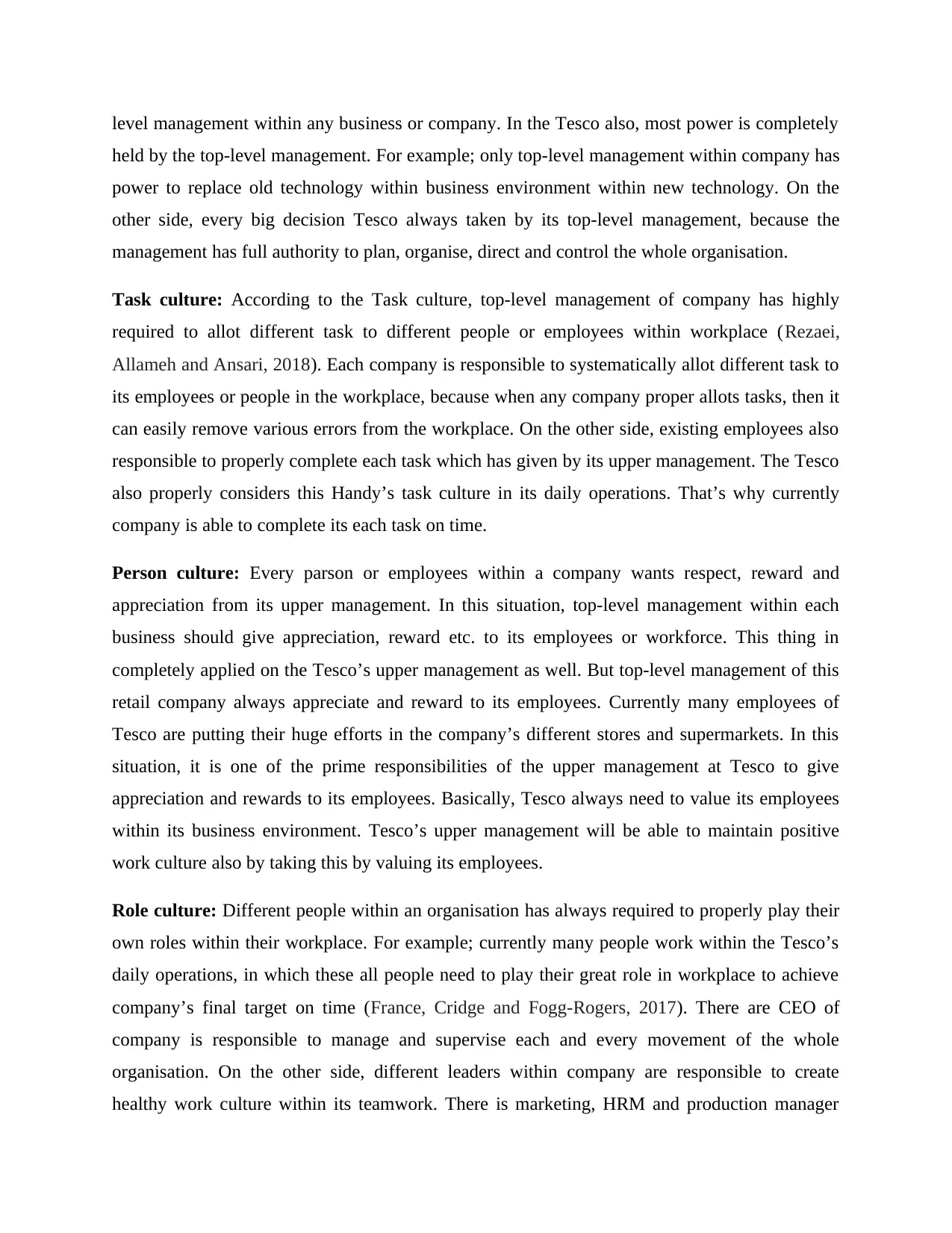
level management within any business or company. In the Tesco also, most power is completely
held by the top-level management. For example; only top-level management within company has
power to replace old technology within business environment within new technology. On the
other side, every big decision Tesco always taken by its top-level management, because the
management has full authority to plan, organise, direct and control the whole organisation.
Task culture: According to the Task culture, top-level management of company has highly
required to allot different task to different people or employees within workplace (Rezaei,
Allameh and Ansari, 2018). Each company is responsible to systematically allot different task to
its employees or people in the workplace, because when any company proper allots tasks, then it
can easily remove various errors from the workplace. On the other side, existing employees also
responsible to properly complete each task which has given by its upper management. The Tesco
also properly considers this Handy’s task culture in its daily operations. That’s why currently
company is able to complete its each task on time.
Person culture: Every parson or employees within a company wants respect, reward and
appreciation from its upper management. In this situation, top-level management within each
business should give appreciation, reward etc. to its employees or workforce. This thing in
completely applied on the Tesco’s upper management as well. But top-level management of this
retail company always appreciate and reward to its employees. Currently many employees of
Tesco are putting their huge efforts in the company’s different stores and supermarkets. In this
situation, it is one of the prime responsibilities of the upper management at Tesco to give
appreciation and rewards to its employees. Basically, Tesco always need to value its employees
within its business environment. Tesco’s upper management will be able to maintain positive
work culture also by taking this by valuing its employees.
Role culture: Different people within an organisation has always required to properly play their
own roles within their workplace. For example; currently many people work within the Tesco’s
daily operations, in which these all people need to play their great role in workplace to achieve
company’s final target on time (France, Cridge and Fogg-Rogers, 2017). There are CEO of
company is responsible to manage and supervise each and every movement of the whole
organisation. On the other side, different leaders within company are responsible to create
healthy work culture within its teamwork. There is marketing, HRM and production manager
held by the top-level management. For example; only top-level management within company has
power to replace old technology within business environment within new technology. On the
other side, every big decision Tesco always taken by its top-level management, because the
management has full authority to plan, organise, direct and control the whole organisation.
Task culture: According to the Task culture, top-level management of company has highly
required to allot different task to different people or employees within workplace (Rezaei,
Allameh and Ansari, 2018). Each company is responsible to systematically allot different task to
its employees or people in the workplace, because when any company proper allots tasks, then it
can easily remove various errors from the workplace. On the other side, existing employees also
responsible to properly complete each task which has given by its upper management. The Tesco
also properly considers this Handy’s task culture in its daily operations. That’s why currently
company is able to complete its each task on time.
Person culture: Every parson or employees within a company wants respect, reward and
appreciation from its upper management. In this situation, top-level management within each
business should give appreciation, reward etc. to its employees or workforce. This thing in
completely applied on the Tesco’s upper management as well. But top-level management of this
retail company always appreciate and reward to its employees. Currently many employees of
Tesco are putting their huge efforts in the company’s different stores and supermarkets. In this
situation, it is one of the prime responsibilities of the upper management at Tesco to give
appreciation and rewards to its employees. Basically, Tesco always need to value its employees
within its business environment. Tesco’s upper management will be able to maintain positive
work culture also by taking this by valuing its employees.
Role culture: Different people within an organisation has always required to properly play their
own roles within their workplace. For example; currently many people work within the Tesco’s
daily operations, in which these all people need to play their great role in workplace to achieve
company’s final target on time (France, Cridge and Fogg-Rogers, 2017). There are CEO of
company is responsible to manage and supervise each and every movement of the whole
organisation. On the other side, different leaders within company are responsible to create
healthy work culture within its teamwork. There is marketing, HRM and production manager
Paraphrase This Document
Need a fresh take? Get an instant paraphrase of this document with our AI Paraphraser
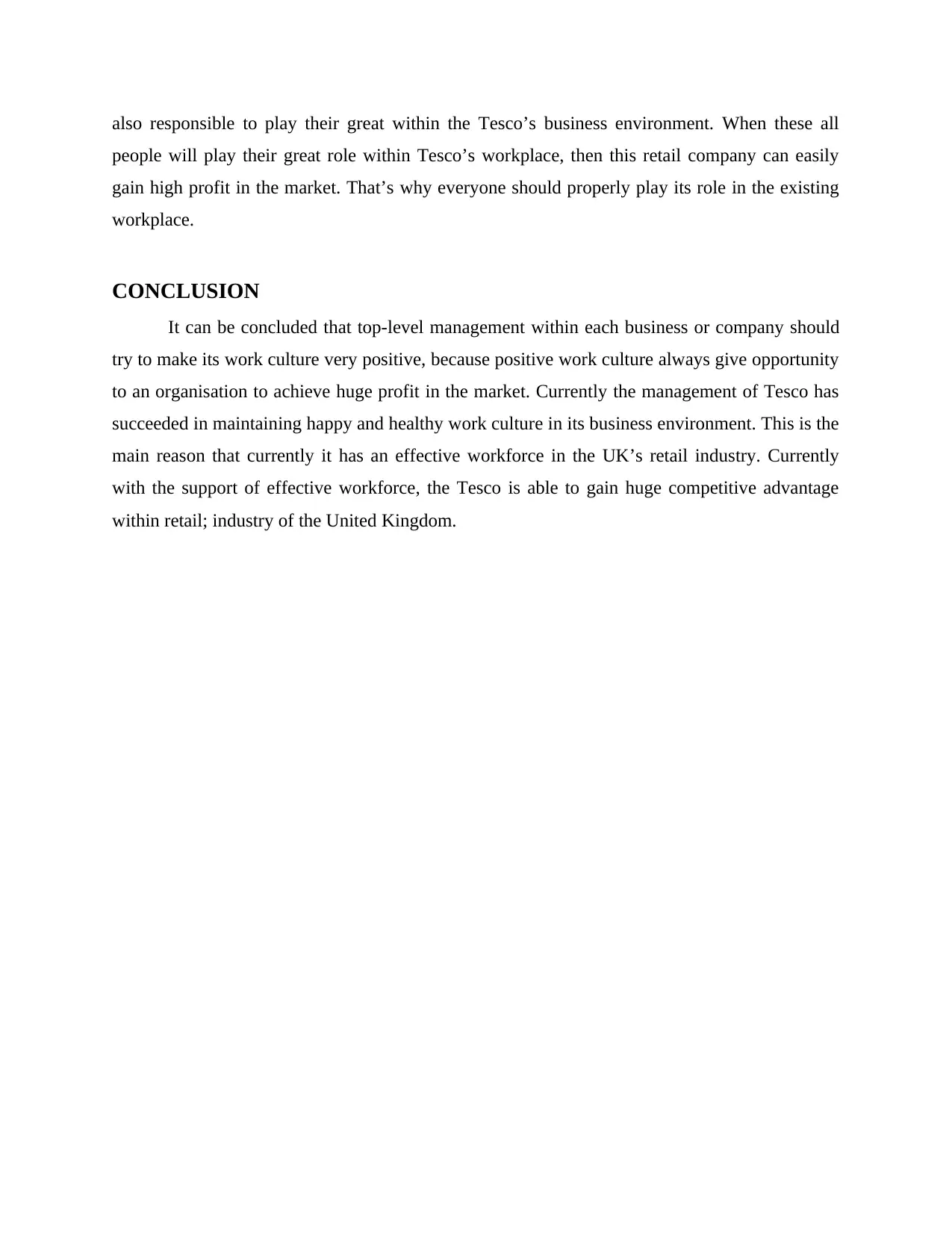
also responsible to play their great within the Tesco’s business environment. When these all
people will play their great role within Tesco’s workplace, then this retail company can easily
gain high profit in the market. That’s why everyone should properly play its role in the existing
workplace.
CONCLUSION
It can be concluded that top-level management within each business or company should
try to make its work culture very positive, because positive work culture always give opportunity
to an organisation to achieve huge profit in the market. Currently the management of Tesco has
succeeded in maintaining happy and healthy work culture in its business environment. This is the
main reason that currently it has an effective workforce in the UK’s retail industry. Currently
with the support of effective workforce, the Tesco is able to gain huge competitive advantage
within retail; industry of the United Kingdom.
people will play their great role within Tesco’s workplace, then this retail company can easily
gain high profit in the market. That’s why everyone should properly play its role in the existing
workplace.
CONCLUSION
It can be concluded that top-level management within each business or company should
try to make its work culture very positive, because positive work culture always give opportunity
to an organisation to achieve huge profit in the market. Currently the management of Tesco has
succeeded in maintaining happy and healthy work culture in its business environment. This is the
main reason that currently it has an effective workforce in the UK’s retail industry. Currently
with the support of effective workforce, the Tesco is able to gain huge competitive advantage
within retail; industry of the United Kingdom.

REFERENCES
Books & Journals
Chumg, H. F., and et.al., 2016. Factors affecting employees' knowledge-sharing behaviour in the
virtual organisation from the perspectives of well-being and organisational
behaviour. Computers in Human Behavior. 64. pp.432-448.
Fielding, S., 2018. Labour’s organisational culture. In The Labour Governments 1964–70
volume 1. Manchester University Press.
France, B., Cridge, B. and Fogg-Rogers, L., 2017. Organisational culture and its role in
developing a sustainable science communication platform. International Journal of
Science Education. Part B. 7(2). pp.146-160.
Intezari, A. and McKenna, B., 2018. Creating organisational culture. Leadership: Regional and
Global Perspectives. p.160.
Kanapathy, K., and et.al., 2017. The impact of soft TQM and hard TQM on innovation
performance: the moderating effect of organisational culture. International Journal of
Productivity and Quality Management. 20(4). pp.429-461.
Lo, M. C., and et.al., 2017. THE ROLE OF KNOWLEDGE MANAGEMENT ON
ORGANISATIONAL EFFECTIVENESS: ORGANISATIONAL CULTURE AS THE
MODERATOR. International Journal of Business & Society. 18.
Lu, V. N., Plewa, C. and Ho, J., 2016. Managing governmental business relationships: the impact
of organisational culture difference and compatibility. Australasian Marketing Journal
(AMJ). 24(1). pp.93-100.
Rezaei, A., Allameh, S. M. and Ansari, R., 2018. Effect of organisational culture and
organisational learning on organisational innovation: an empirical
investigation. International Journal of Productivity and Quality Management. 23(3).
pp.307-327.
Samuel, A. B., and et.al., 2017. A synthesised literature review on organisational culture and
corporate performance. Journal of Advanced Research in Social and Behavioural
Sciences Journal Homepage. 7(1). pp.83-95.
Wiener, M., Gattringer, R. and Strehl, F., 2018. Participation in inter-organisational collaborative
open foresight A matter of culture. Technology Analysis & Strategic
Management. 30(6). pp.684-700.
Books & Journals
Chumg, H. F., and et.al., 2016. Factors affecting employees' knowledge-sharing behaviour in the
virtual organisation from the perspectives of well-being and organisational
behaviour. Computers in Human Behavior. 64. pp.432-448.
Fielding, S., 2018. Labour’s organisational culture. In The Labour Governments 1964–70
volume 1. Manchester University Press.
France, B., Cridge, B. and Fogg-Rogers, L., 2017. Organisational culture and its role in
developing a sustainable science communication platform. International Journal of
Science Education. Part B. 7(2). pp.146-160.
Intezari, A. and McKenna, B., 2018. Creating organisational culture. Leadership: Regional and
Global Perspectives. p.160.
Kanapathy, K., and et.al., 2017. The impact of soft TQM and hard TQM on innovation
performance: the moderating effect of organisational culture. International Journal of
Productivity and Quality Management. 20(4). pp.429-461.
Lo, M. C., and et.al., 2017. THE ROLE OF KNOWLEDGE MANAGEMENT ON
ORGANISATIONAL EFFECTIVENESS: ORGANISATIONAL CULTURE AS THE
MODERATOR. International Journal of Business & Society. 18.
Lu, V. N., Plewa, C. and Ho, J., 2016. Managing governmental business relationships: the impact
of organisational culture difference and compatibility. Australasian Marketing Journal
(AMJ). 24(1). pp.93-100.
Rezaei, A., Allameh, S. M. and Ansari, R., 2018. Effect of organisational culture and
organisational learning on organisational innovation: an empirical
investigation. International Journal of Productivity and Quality Management. 23(3).
pp.307-327.
Samuel, A. B., and et.al., 2017. A synthesised literature review on organisational culture and
corporate performance. Journal of Advanced Research in Social and Behavioural
Sciences Journal Homepage. 7(1). pp.83-95.
Wiener, M., Gattringer, R. and Strehl, F., 2018. Participation in inter-organisational collaborative
open foresight A matter of culture. Technology Analysis & Strategic
Management. 30(6). pp.684-700.
⊘ This is a preview!⊘
Do you want full access?
Subscribe today to unlock all pages.

Trusted by 1+ million students worldwide
1 out of 9
Related Documents
Your All-in-One AI-Powered Toolkit for Academic Success.
+13062052269
info@desklib.com
Available 24*7 on WhatsApp / Email
![[object Object]](/_next/static/media/star-bottom.7253800d.svg)
Unlock your academic potential
Copyright © 2020–2025 A2Z Services. All Rights Reserved. Developed and managed by ZUCOL.





